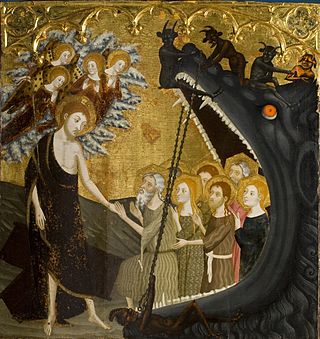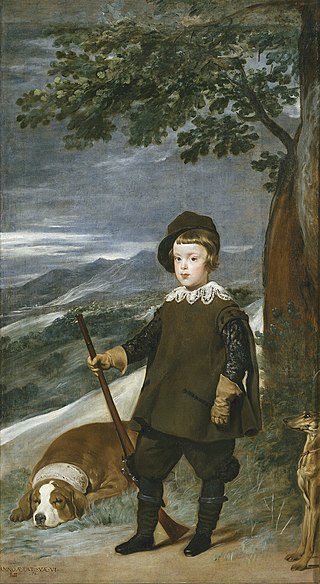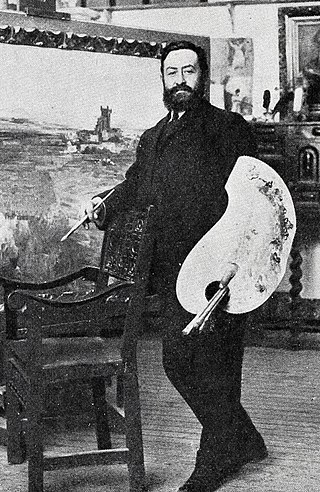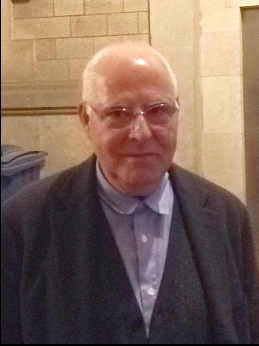
(date unknown)
Jaume Morera i Galícia (1854 – 24 April 1927) was a Catalan landscape painter.

Jaume Morera i Galícia (1854 – 24 April 1927) was a Catalan landscape painter.
He was born in Lleida. His family was from a small town and had been attracted to Lleida by business opportunities. He moved to Madrid to study landscape painting at the Real Academia de Bellas Artes de San Fernando under Carlos de Haes. [1] In 1874, he was chosen to be one of the first students at the newly founded Spanish Academy in Rome, [2] together with Francisco Pradilla, Casto Plasencia and Alejandro Ferrant. While there, he produced many paintings of the Italian countryside in the Academic style.
Upon his return to Spain in 1877, he stayed only briefly in Lleida, then established himself in Madrid. [1] Nevertheless, he maintained a lifetime connection to his native city. From his base in Madrid, he travelled widely, often accompanied by Haes, visiting the Netherlands, Belgium and France. From these places, he produced works that he displayed at the annual National Exhibition of Fine Arts, winning several medals. [3] In 1900, he married María Felisa Alday, [2] who had been Carlos de Haes' caretaker during the latter's final days. The couple took up residence on a farm near a small village between Madrid and the Basque Country.

In 1915, he returned to his hometown to help establish the "Museu d'Art Modern de Lleida", a large portion of which was devoted to the works of Haes that had been left to him in Haes' will. Eventually, his contributions to the museum were considered so significant that it was renamed the Museu d'Art Jaume Morera in 1924. [2]
He was attracted to Nordic-style landscapes and spent much of his time painting in the Sierra de Guadarrama. He also painted along the coast of Northern Spain near Algorta. [1] He died in Madrid.
His brother was the politician and poet Magí Morera .

Tourism in Spain is a major contributor to national economic life, contributing to about 11.8% of Spain's GDP. Ever since the 1960s and 1970s, the country has been a popular destination for summer holidays, especially with large numbers of tourists from the United Kingdom, Ireland, Turkey, France, Germany, Italy, the Benelux, and the United States, among others. Accordingly, Spain's foreign tourist industry has grown into the second-biggest in the world.

Jaume Serra was a Catalan painter. Serra was influenced heavily by a Sienese style introduced by Ferrer Bassa.

Prince Balthasar Charles as a Hunter is a 1635 portrait of Balthasar Charles, Prince of Asturias by Diego Velázquez. It is now held at the Museo del Prado.

Darío de Regoyos y Valdés was a Spanish painter. He was notable for contributing to "the renewal of modern Spanish painting". A student of Carlos de Haes at the Real Academia de Bellas Artes de San Fernando in 1878, he later studied at the Académie Royale des Beaux-Arts in Brussels. He traveled extensively in the 1880s, accompanied by his friend, the painter Adolfo Guiard. He was a member of the art group L'Essor and a founding member of Les XX with the Belgian avant-garde scene. During these experiences he gained a significant influence from Impressionist and Neo-Impressionist painters.

Carlos Sebastián Pedro Hubert de Haes was a Spanish painter from Belgium. He was noted for the Realism in his landscapes, and was considered to be the "first contemporary Spanish artist able to capture something of a particularly Spanish 'essence' in his work". He was cited along with Jenaro Perez Villaamil and Aureliano de Beruete as one of the three Spanish grand masters of landscape painting, the latter of which was his pupil.

The Museu d'Art Jaume Morera is a museum in Lleida (Catalonia) created by the Diputació de Lleida and the Lleida City Council with the collaboration of the painter Jaume Morera i Galícia. It is the museum of modern and contemporary art of the city of Lleida. Today is municipally owned and receives financial support from the Diputació de Lleida and the Department of Culture of the Generalitat of Catalonia. Its entrance is free.

Martín Bernat was a Spanish Gothic style painter, active in Zaragoza, where he had a long collaboration with Bartolomé Bermejo. His dates of birth and death are not known.

Antonio de Puga, was a Spanish Baroque painter.

Antoni Abad i Roses is a Spanish artist. He began his career as a sculptor, and evolved over time towards video art and later in net.art and other forms of new media.

Rodrigo de Osona, also Rodrigo de Osona the Elder, (c.1440–c.1518) was a Spanish Renaissance painter.

Xavier Gosé i Rovira was a Catalan painter and illustrator who worked in the Art Nouveau and Art Déco styles.

Aureliano de Beruete was a Spanish landscape painter, art critic and social activist.

Baldomer Gili i Roig was a Spanish painter, draftsman and photographer.

Jaime Serra Palou is a Catalan artist and journalist, specialized in infographics and data visualization design. He is the Director of Infographics and Illustration at La Vanguardia newspaper since October 2007, where since 2010 he publishes a column called A Sunday Paradox.

Miguel Ximénez was a Spanish Gothic painter.

Francesc Gimeno i Arasa was a Spanish painter and graphic artist; best known for his landscapes, city scenes and self-portraits.

Marceliano Santa María was a Spanish painter, noted for his Castilian landscapes, historical art, and portraits.

Antoni Llena is a Spanish artist.

Francisco Llorens Díaz was a Spanish-Galician painter; best known for still-lifes and landscapes.